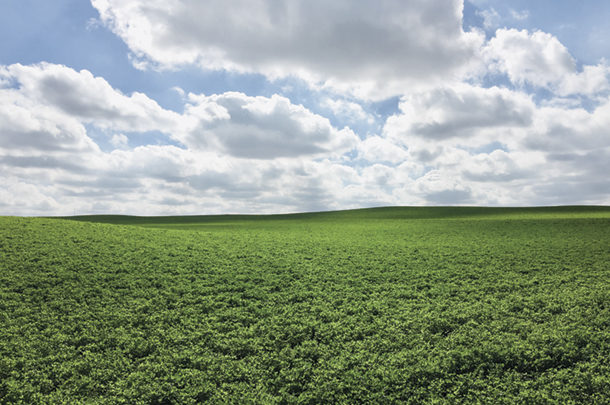As with any new technology, some corresponding management changes must occur to optimize value of the technology. With haymaking, this means speeding up drying rate to minimize respiratory carbohydrate loss and leaf loss.
First, a basic physical concept of drying hay: The biggest drying factor is sunlight. When hay is put into a 5-foot-wide windrow while mowing with a 13- to 16-foot cutter bar, you are intercepting and using only 30% to 35% of the sunlight that is falling on the field. Spreading the forage into a wide swath will allow up to 100% of the sunlight falling on the field to be used for drying hay. Better use of sunlight will reduce drying time by one to two days.
Slower hay drying in a windrow allows respiration to continue longer, resulting in a 4% to 6% loss of starch and sugar (dry matter basis). In addition to the 4% to 6% yield loss, this means a loss of about 20 points relative feed quality.
Conditioning is important for drying alfalfa for hay but is a distant second to the importance of sunlight. Conditioning with rollers breaks the stems for enhanced drying – it does not affect leaf drying. Impeller conditioners scrape the stem rather than break it but are not recommended for alfalfa due to higher leaf loss.
Some have reported that lower-lignin varieties of alfalfa don’t crimp well (more like a wet noodle going through the rollers) and are harder to dry. Before we blame the genetics, we should be careful to eliminate all mechanical and environmental conditions that could cause “limpy” alfalfa.
Some poor drying is due to maladjusted conditioners on the mower. Roller conditioners have two adjustments of importance. First, the roller spacing should be adjusted to 1/8-inch. You can test this by making three 1-inch-diameter rolls of aluminum foil from the kitchen and feeding one through on each side and one in the middle of the rolls. Measure the thickness of the thinnest portion of the aluminum rolls after feeding through to determine roller spacing. If the middle one has wider spacing than either edge, the rolls have worn and should be replaced. Secondly, the roller tension should be adjusted for each field depending on the yield. Increase tension so that 1% to 5% of the alfalfa leaves show some bruising.
Environmental factors can greatly affect the rigidity of the alfalfa stem. All plants grow by first forming a primary cell wall around new cells. The primary cell wall is a thin, flexible and extensible layer composed of cellulose, pectin and hemicellulose (especially xyloglucan). Cells with largely primary cell walls are most noticeable in newly formed stems, which can easily bend in the wind. The flexibility allows cells to grow in size. Later, the secondary cell wall forms beneath the primary cell wall. This contains the lignin, which creates rigidity.
Lignin formation is very sensitive to temperature and sunlight. Cooler temperatures result in reduced lignin. Therefore, first cutting, generally grown under cooler weather, tends to have less lignin and higher digestibility than later cuttings. Similarly, the cooler temperatures of higher elevations tend to result in higher fiber digestibility due to reduced lignin.
Lignin formation is also very sensitive to the amount of infrared light in sunlight. This is why plants grown in a greenhouse are often spindly (because the infrared sunlight cannot penetrate the greenhouse glass). Similarly, field-grown plants maturing in cloudy conditions tend to have less lignin because the clouds intercept the infrared light.
As a side note, the above two factors are why alfalfa stem size has little relation to forage digestibility. The biggest diameter stems occur generally on first cutting when fiber digestibility is highest. The smallest diameter stems generally occur during a drought when sunlight (and infrared light) is high and fiber digestibility is low.
Another consideration is that truly “limpy” alfalfa would not stand up well prior to cutting. Many measurements of lodging resistance have been taken across the U.S., and none have indicated that reduced-lignin alfalfa varieties are more likely to lodge than conventional alfalfa varieties.
When comparing alfalfa varieties for any trait, it is important to ensure that any difference noted is not due to operational or environmental comparisons. This means varieties to be compared must be of the same age, managed identically for soil fertility and pest control, and harvested at the same time (we actually sent out two mowers, one for each variety when doing comparisons).
All of the trials we have run have indicated no difference in conditioning or hay drying when comparing conventional to lower-lignin varieties. ![]()
Getty Images.

-
Dan Undersander
- Forage Professor Emeritus
- University of Wisconsin
- Email Dan Undersander











